|
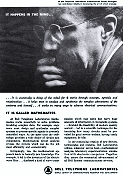 Anyone who has taken electronics design
courses is familiar with the basic Darlington amplifier construct featuring two
cascaded transistors having the collectors of both transistors tied directly together,
and the emitter of the first transistor connected directly to the base of the second.
The Darlington transistor is fabricated on its semiconductor substrate, and is packaged
like a standard three-terminal transistor. Its advantage is high gain due to the
multiplication of beta (current gain) values. The device's inventor,
Sidney Darlington, worked at - no surprise - Bell Telephone Laboratories. This
1961 promo for Bell Labs appeared in a 1961 issue of Radio-Electronics magazine.
Its primary intent was to highlight the importance of mathematics in all research
and development endeavors, using Mr. Darlington's... Anyone who has taken electronics design
courses is familiar with the basic Darlington amplifier construct featuring two
cascaded transistors having the collectors of both transistors tied directly together,
and the emitter of the first transistor connected directly to the base of the second.
The Darlington transistor is fabricated on its semiconductor substrate, and is packaged
like a standard three-terminal transistor. Its advantage is high gain due to the
multiplication of beta (current gain) values. The device's inventor,
Sidney Darlington, worked at - no surprise - Bell Telephone Laboratories. This
1961 promo for Bell Labs appeared in a 1961 issue of Radio-Electronics magazine.
Its primary intent was to highlight the importance of mathematics in all research
and development endeavors, using Mr. Darlington's...
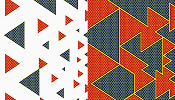 "Researchers have created tiny transistors
by using some of the world's thinnest wires as gate electrodes - the crucial parts
that turns transistors on and off. Rather than using silicon or metal, the researchers
fashioned this gate from molybdenum disulfide - a semiconductor that could take
over from silicon in coming decades. When two misaligned shards of MoS2 come together,
their borderline becomes a wire just 0.4 nanometers thick, far smaller than even
the smallest parts of the transistors in today's most advanced CPUs. The researchers,
mostly based at South Korea's Institute of Basic Science, integrated this wire as
a key component of an ultrasmall
transistor..." "Researchers have created tiny transistors
by using some of the world's thinnest wires as gate electrodes - the crucial parts
that turns transistors on and off. Rather than using silicon or metal, the researchers
fashioned this gate from molybdenum disulfide - a semiconductor that could take
over from silicon in coming decades. When two misaligned shards of MoS2 come together,
their borderline becomes a wire just 0.4 nanometers thick, far smaller than even
the smallest parts of the transistors in today's most advanced CPUs. The researchers,
mostly based at South Korea's Institute of Basic Science, integrated this wire as
a key component of an ultrasmall
transistor..."
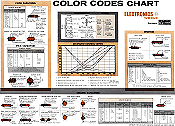 "Who needs another
color code chart?," you might be asking. Well, as is always the case there are
new people coming into the electronics field all the time and they are looking for
resources just as we were lo those many years ago when we were first smitten by
the science. For that matter, a lot of seasoned electronics professionals and hobbyists
decide to take on the task of refurbishing or repairing vintage equipment and need
a quick reference for interpreting the colored dots and stripes on resistors, capacitors,
and inductors, as well as the colors of transformer lead wires. This one appeared
in a 1959 issue of Electronics World magazine, and it's a valid today as
it was then... "Who needs another
color code chart?," you might be asking. Well, as is always the case there are
new people coming into the electronics field all the time and they are looking for
resources just as we were lo those many years ago when we were first smitten by
the science. For that matter, a lot of seasoned electronics professionals and hobbyists
decide to take on the task of refurbishing or repairing vintage equipment and need
a quick reference for interpreting the colored dots and stripes on resistors, capacitors,
and inductors, as well as the colors of transformer lead wires. This one appeared
in a 1959 issue of Electronics World magazine, and it's a valid today as
it was then...
 Contained in this obituary honoring Alexander
Graham Bell's assistant,
Dr.
Thomas A. Watson, which appeared in the March 1935 issue of Radio-Craft
magazine, is a bit of information about a serendipitous event that led to the invention
of the telephone. I do not recall having heard of it. This is just one more reason
why perusing historical material like these magazines is so important for keeping
alive the details of the other world's momentous events. Many demonstrations have
shown how as stories get passed on from person to person, generation to generation,
some or all of the original details get lost or modified along the way until the
contemporary version of the event barely represents the facts. BTW, I cannot locate
evidence that TAW held a doctorate degree - or any degree for that matter... Contained in this obituary honoring Alexander
Graham Bell's assistant,
Dr.
Thomas A. Watson, which appeared in the March 1935 issue of Radio-Craft
magazine, is a bit of information about a serendipitous event that led to the invention
of the telephone. I do not recall having heard of it. This is just one more reason
why perusing historical material like these magazines is so important for keeping
alive the details of the other world's momentous events. Many demonstrations have
shown how as stories get passed on from person to person, generation to generation,
some or all of the original details get lost or modified along the way until the
contemporary version of the event barely represents the facts. BTW, I cannot locate
evidence that TAW held a doctorate degree - or any degree for that matter...
 Researchers have developed a novel technique
for nanofabrication within silicon that allows for the creation of buried nanostructures
with feature sizes down to 100 nm. By utilizing spatially-modulated laser pulses,
they have achieved unprecedented control and precision in creating
nanophotonic elements, offering significant potential for advancements in electronics
and photonics. A new method enables precise nanofabrication inside silicon using
spatial light modulation and laser pulses, creating advanced nanostructures for
potential use in electronics... Researchers have developed a novel technique
for nanofabrication within silicon that allows for the creation of buried nanostructures
with feature sizes down to 100 nm. By utilizing spatially-modulated laser pulses,
they have achieved unprecedented control and precision in creating
nanophotonic elements, offering significant potential for advancements in electronics
and photonics. A new method enables precise nanofabrication inside silicon using
spatial light modulation and laser pulses, creating advanced nanostructures for
potential use in electronics...
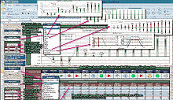 RF Cascade Workbook is the next phase in the evolution of RF Cafe's long-running
series, RF Cascade Workbook. Chances are you have never used a spreadsheet
quite like this (click
here for screen capture). It is a full-featured RF system cascade parameter
and frequency planner that includes filters and mixers for a mere $45. Built in
MS Excel, using RF Cascade Workbook is a cinch and the format
is entirely customizable. It is significantly easier and faster than using a multi-thousand
dollar simulator when a high level system analysis is all that is needed...
RF Cascade Workbook is the next phase in the evolution of RF Cafe's long-running
series, RF Cascade Workbook. Chances are you have never used a spreadsheet
quite like this (click
here for screen capture). It is a full-featured RF system cascade parameter
and frequency planner that includes filters and mixers for a mere $45. Built in
MS Excel, using RF Cascade Workbook is a cinch and the format
is entirely customizable. It is significantly easier and faster than using a multi-thousand
dollar simulator when a high level system analysis is all that is needed...
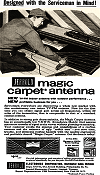 In my 66 years, I have been in many attics
- first as an electrician who did a lot of house calls, and then as an owner of
many homes (one at a time, not an investor; that takes money, which I don't have).
Not once in my recollection did I see a
Magic Carpet Antenna. I'm guessing they would have been more likely to be installed
in urban and nearby suburban environments that were located relatively close to
a broadcast station. Its depicted installation in a horizontally polarized orientation
might have provided about as much received power as a rooftop multielement antenna,
and was maybe better than a set of rabbit eats on the TV set. Regardless, it clearly
has some amount of directivity, which means its orientation is fixed - no going
up on the roof to rotate the antenna or using... In my 66 years, I have been in many attics
- first as an electrician who did a lot of house calls, and then as an owner of
many homes (one at a time, not an investor; that takes money, which I don't have).
Not once in my recollection did I see a
Magic Carpet Antenna. I'm guessing they would have been more likely to be installed
in urban and nearby suburban environments that were located relatively close to
a broadcast station. Its depicted installation in a horizontally polarized orientation
might have provided about as much received power as a rooftop multielement antenna,
and was maybe better than a set of rabbit eats on the TV set. Regardless, it clearly
has some amount of directivity, which means its orientation is fixed - no going
up on the roof to rotate the antenna or using...
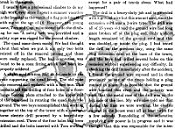 This 1966 QST magazine story relates
a lesson learned by the author and thousands of others ever since electric power
appliances and tools first became available. Fortunately, his Ham buddy was not
permanently harmed, but even today with all the effort put into educating the public,
people continue to use ungrounded (2-wire type, or with the ground prong removed)
extension cords in conjunction with 3-wire power cords on tools and end up electrocuting
themselves (or somebody else). I've told the story before about a friend of mine
from high school who shortly after graduation was making a piece of furniture in
a garage that had a damp dirt floor, and was
electrocuted to death
by the metal-framed circular saw that had no ground connected. Nowadays we often
have power provided by a GFCI receptacle... This 1966 QST magazine story relates
a lesson learned by the author and thousands of others ever since electric power
appliances and tools first became available. Fortunately, his Ham buddy was not
permanently harmed, but even today with all the effort put into educating the public,
people continue to use ungrounded (2-wire type, or with the ground prong removed)
extension cords in conjunction with 3-wire power cords on tools and end up electrocuting
themselves (or somebody else). I've told the story before about a friend of mine
from high school who shortly after graduation was making a piece of furniture in
a garage that had a damp dirt floor, and was
electrocuted to death
by the metal-framed circular saw that had no ground connected. Nowadays we often
have power provided by a GFCI receptacle...
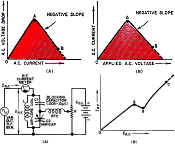 Most RF Cafe visitors are familiar with
the negative resistance region exhibited in tunnel diodes. It is what makes them
usable, among other special applications, as oscillators. Although a diode is often
part of an AC circuit, it is fundamentally thought of as a DC device since it permits
conduction in only one direction (the exception being a Zener diode). An AC device
in general refers to something used in a line supply circuit at 50 Hz, 60 Hz,
or even 400 Hz. Such is the case with this 1963 Electronics World
magazine article, which describes
negative resistance characteristics of voltage-variable capacitors (varactor)
and ferroresonant devices like saturable coils... Most RF Cafe visitors are familiar with
the negative resistance region exhibited in tunnel diodes. It is what makes them
usable, among other special applications, as oscillators. Although a diode is often
part of an AC circuit, it is fundamentally thought of as a DC device since it permits
conduction in only one direction (the exception being a Zener diode). An AC device
in general refers to something used in a line supply circuit at 50 Hz, 60 Hz,
or even 400 Hz. Such is the case with this 1963 Electronics World
magazine article, which describes
negative resistance characteristics of voltage-variable capacitors (varactor)
and ferroresonant devices like saturable coils...
 Crane Aerospace & Electronics, a segment
of Crane Company, has developed a family of
beamformer backplane products for space applications utilizing its proprietary
Multi-Mix® multi-layer laminate technology. "We are integrating arrays of radiating
elements with associated feed networks and RFICs into a single module for space
applications throughout the Microwave and mmWave frequency range," said Jim Logothetis,
Director of Engineering, Microwave Solutions. "Fusion bonding is used to increase
circuit density, minimize layer count, and reduce the required footprint, which
results in the smallest footprint and highest RF performance for these challenging
applications..." Crane Aerospace & Electronics, a segment
of Crane Company, has developed a family of
beamformer backplane products for space applications utilizing its proprietary
Multi-Mix® multi-layer laminate technology. "We are integrating arrays of radiating
elements with associated feed networks and RFICs into a single module for space
applications throughout the Microwave and mmWave frequency range," said Jim Logothetis,
Director of Engineering, Microwave Solutions. "Fusion bonding is used to increase
circuit density, minimize layer count, and reduce the required footprint, which
results in the smallest footprint and highest RF performance for these challenging
applications..."
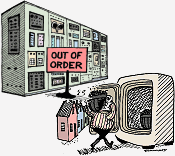 I needed to look up the definition of "callithump."
I have to admit to not really being sure why the title seemed apt to the editors.
This is two separate mini-stories. The first, "A Dubious Tale," is a clever
manipulation of a very familiar electronics / electrical mathematical law applied
to a fictional town located on the shores of Scandinavia. The second, "A Day in
a 1985 School," set in the mid-1960s, tells a futuristic tale - projected way forward
into the 1980s - of a discussion between a father and his son regarding how things
are going at school. Unlike similar predictions in the 1960s of a flying car in
every garage and Dick Tracey watches on every wrist, this scenario has, although
not exactly... I needed to look up the definition of "callithump."
I have to admit to not really being sure why the title seemed apt to the editors.
This is two separate mini-stories. The first, "A Dubious Tale," is a clever
manipulation of a very familiar electronics / electrical mathematical law applied
to a fictional town located on the shores of Scandinavia. The second, "A Day in
a 1985 School," set in the mid-1960s, tells a futuristic tale - projected way forward
into the 1980s - of a discussion between a father and his son regarding how things
are going at school. Unlike similar predictions in the 1960s of a flying car in
every garage and Dick Tracey watches on every wrist, this scenario has, although
not exactly...
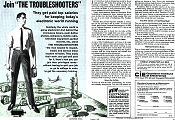 As mentioned often here on RF Cafe,
especially with an ever-increasing amount of devices and appliances with "no user
serviceable parts inside," the demand for
electronics technicians is as great today as it was decades ago. Associated
equipment is significantly different now and a lot more of it consists of swap-out
modules and assemblies rather than performing repairs in the field. However, there
still exists a significant amount of legacy electronics everywhere, and it all needs
to be maintained until upgrades are installed. There are still many electronics
repair depots around the world with teams of electronics techs doing component level
troubleshooting and repair. The Internet is awash... As mentioned often here on RF Cafe,
especially with an ever-increasing amount of devices and appliances with "no user
serviceable parts inside," the demand for
electronics technicians is as great today as it was decades ago. Associated
equipment is significantly different now and a lot more of it consists of swap-out
modules and assemblies rather than performing repairs in the field. However, there
still exists a significant amount of legacy electronics everywhere, and it all needs
to be maintained until upgrades are installed. There are still many electronics
repair depots around the world with teams of electronics techs doing component level
troubleshooting and repair. The Internet is awash...
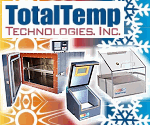 TotalTemp Technologies has more than 40
years of combined experience providing thermal platforms.
Thermal Platforms are
available to provide temperatures between -100°C and +200°C for cryogenic cooling,
recirculating & circulating coolers, temperature chambers and temperature controllers,
thermal range safety controllers, space simulation chambers, hybrid benchtop chambers,
custom systems and platforms. Manual and automated configurations for laboratory
and production environments. Please contact TotalTemp Technologies today to learn
how they can help your project. TotalTemp Technologies has more than 40
years of combined experience providing thermal platforms.
Thermal Platforms are
available to provide temperatures between -100°C and +200°C for cryogenic cooling,
recirculating & circulating coolers, temperature chambers and temperature controllers,
thermal range safety controllers, space simulation chambers, hybrid benchtop chambers,
custom systems and platforms. Manual and automated configurations for laboratory
and production environments. Please contact TotalTemp Technologies today to learn
how they can help your project.
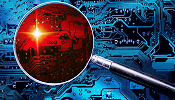 The semiconductor industry's technological
advances make it a prime target for espionage, facilitating protective measures
and design strategies to protect intellectual property. While the semiconductor
industry continues to become more lucrative, with revenue projected to increase
to $630 billion in 2024, it's also a prime target for
espionage and theft. Several trends are influencing the espionage landscape,
including an increased focus on cyber and economic espionage and state-sponsored
activities. Cyberattacks, hacking, and other sophisticated techniques have also
evolved and become more prevalent. For instance, the U.S. government continues to
uphold a ban on importing... The semiconductor industry's technological
advances make it a prime target for espionage, facilitating protective measures
and design strategies to protect intellectual property. While the semiconductor
industry continues to become more lucrative, with revenue projected to increase
to $630 billion in 2024, it's also a prime target for
espionage and theft. Several trends are influencing the espionage landscape,
including an increased focus on cyber and economic espionage and state-sponsored
activities. Cyberattacks, hacking, and other sophisticated techniques have also
evolved and become more prevalent. For instance, the U.S. government continues to
uphold a ban on importing...
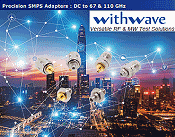 Withwave is a leading designer and developer
of a broad range of RF, microwave, and millimeter-wave test solutions and subsystems
with a focus on electromagnetic field analysis and signal processing. Withwave's
s
Precision SMPS Adapters are between-series types designed based on precision
microwave interconnection technologies for materials and machining. These precision
microwave connector interfaces ensure excellent performance up to 67 & 110 GHz,
over a temperature range of -65 to +165° C. Typical VSWR is DC to 67 GHz:
1.30:1, DC to 100 GHz: 1.50:1, and DC to 110 GHz: 1.80:1... Withwave is a leading designer and developer
of a broad range of RF, microwave, and millimeter-wave test solutions and subsystems
with a focus on electromagnetic field analysis and signal processing. Withwave's
s
Precision SMPS Adapters are between-series types designed based on precision
microwave interconnection technologies for materials and machining. These precision
microwave connector interfaces ensure excellent performance up to 67 & 110 GHz,
over a temperature range of -65 to +165° C. Typical VSWR is DC to 67 GHz:
1.30:1, DC to 100 GHz: 1.50:1, and DC to 110 GHz: 1.80:1...
 Banner Ads are rotated in all locations
on the page! RF Cafe typically receives 8,000-15,000 visits each
weekday. RF Cafe
is a favorite of engineers, technicians, hobbyists, and students all over the world.
With more than 17,000 pages in the Google search index, RF Cafe returns in
favorable positions on many types of key searches, both for text and images.
Your Banner Ads are displayed on average0,000 times per year! New content
is added on a daily basis, which keeps the major search engines interested enough
to spider it multiple times each day. Items added on the homepage often can be found
in a Google search within a few hours of being posted. If you need your company
news to be seen, RF Cafe is the place to be... Banner Ads are rotated in all locations
on the page! RF Cafe typically receives 8,000-15,000 visits each
weekday. RF Cafe
is a favorite of engineers, technicians, hobbyists, and students all over the world.
With more than 17,000 pages in the Google search index, RF Cafe returns in
favorable positions on many types of key searches, both for text and images.
Your Banner Ads are displayed on average0,000 times per year! New content
is added on a daily basis, which keeps the major search engines interested enough
to spider it multiple times each day. Items added on the homepage often can be found
in a Google search within a few hours of being posted. If you need your company
news to be seen, RF Cafe is the place to be...
• Private 5G Tech Competes
with Wi-Fi
•
Taiwan Enjoys Growing Role in Electronics Startups
•
RFID Market CAGR of 11.1% to $40.9B by 2032
• GaN
HEMTs on 8-Inch Sapphire
• U.S. Launches
Probe into Chinese Telcos
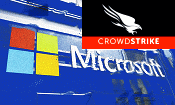 You might have noticed earlier today that
my RFCafe.com,
RFCafe.net, and
AirplanesAndRockets.com websites
were down (fortunately, they're back up now). According to my web host, it was due
to the global outage caused by a
CrowdStrike security update affecting Microsoft servers. "Banks, airports, TV
stations, health care organizations, hotels, and countless other businesses are
all facing widespread IT outages, leaving flights grounded and causing widespread
disruption, after Windows machines have displayed errors worldwide. In the early
hours of Friday, companies in Australia running Microsoft's Windows operating system
started reporting devices showing Blue Screens of Death (BSODs). Shortly after,
reports of disruptions started flooding in from around the world, including from
the UK, India, Germany, the Netherlands, and the US: TV station Sky News went offline,
and US airlines United, Delta, and American Airlines issued a 'global ground stop'
on all flights..." You might have noticed earlier today that
my RFCafe.com,
RFCafe.net, and
AirplanesAndRockets.com websites
were down (fortunately, they're back up now). According to my web host, it was due
to the global outage caused by a
CrowdStrike security update affecting Microsoft servers. "Banks, airports, TV
stations, health care organizations, hotels, and countless other businesses are
all facing widespread IT outages, leaving flights grounded and causing widespread
disruption, after Windows machines have displayed errors worldwide. In the early
hours of Friday, companies in Australia running Microsoft's Windows operating system
started reporting devices showing Blue Screens of Death (BSODs). Shortly after,
reports of disruptions started flooding in from around the world, including from
the UK, India, Germany, the Netherlands, and the US: TV station Sky News went offline,
and US airlines United, Delta, and American Airlines issued a 'global ground stop'
on all flights..."
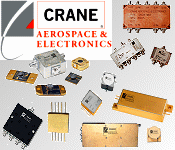 Crane Aerospace & Electronics' products
and services are organized into six integrated solutions: Cabin Systems, Electrical
Power Solutions, Fluid Management Solutions, Landing Systems, Microwave Solutions,
and Sensing Components & Systems. Our Microwave Solution designs and manufactures
high-performance
RF, IF and millimeter-wave components, subsystems and systems for commercial
aviation, defense, and space including linear & log amplifiers, fixed &
variable attenuators, circulators & isolators, power combiners & dividers,
couplers, mixers, switches & matrices, oscillators & synthesizers. Crane Aerospace & Electronics' products
and services are organized into six integrated solutions: Cabin Systems, Electrical
Power Solutions, Fluid Management Solutions, Landing Systems, Microwave Solutions,
and Sensing Components & Systems. Our Microwave Solution designs and manufactures
high-performance
RF, IF and millimeter-wave components, subsystems and systems for commercial
aviation, defense, and space including linear & log amplifiers, fixed &
variable attenuators, circulators & isolators, power combiners & dividers,
couplers, mixers, switches & matrices, oscillators & synthesizers.
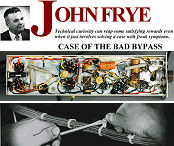 It seems the title, "Mac's
Radio Service Shop" for John Frye's tech tales might have been dropped after
Radio & Television News magazine changed its name to Electronics
World in May of 1959. The characters' names and roles were all the same, but
the title was dropped - probably to not bias the new theme of the magazine. This
episode discusses some of the strange ways in which a faulty bypass capacitor can
manifest itself. A big part of effective troubleshooting is the experience of "having
seen that before." Interestingly, by 1963 vacuum tubes were still in common use,
but printed wiring boards had been introduced, along with their propensity for developing
broken traces. Also mentioned is why having a safety... It seems the title, "Mac's
Radio Service Shop" for John Frye's tech tales might have been dropped after
Radio & Television News magazine changed its name to Electronics
World in May of 1959. The characters' names and roles were all the same, but
the title was dropped - probably to not bias the new theme of the magazine. This
episode discusses some of the strange ways in which a faulty bypass capacitor can
manifest itself. A big part of effective troubleshooting is the experience of "having
seen that before." Interestingly, by 1963 vacuum tubes were still in common use,
but printed wiring boards had been introduced, along with their propensity for developing
broken traces. Also mentioned is why having a safety...
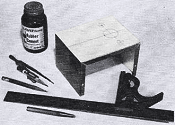 Usually an article about clean
layout techniques would be about printed circuit board layout; however, this
one refers to chassis layout. Having built many electronics chassis in my days as
an electronics technician (prior to earning an engineering degree), I have a great
appreciation for a professional-looking job. In fact, I chose to build most of my
own prototypes as a design engineer as well. Some of the work done by hobbyists
that appear in magazines like QST, Nuts & Volts,
and the older titles like Poplar Electronics looks pretty darn nice, sometimes
like a commercial product - both for kits and homebrews. There are still a lot of
people out there who design and build their own equipment. It's a short article,
but worth a quick look... Usually an article about clean
layout techniques would be about printed circuit board layout; however, this
one refers to chassis layout. Having built many electronics chassis in my days as
an electronics technician (prior to earning an engineering degree), I have a great
appreciation for a professional-looking job. In fact, I chose to build most of my
own prototypes as a design engineer as well. Some of the work done by hobbyists
that appear in magazines like QST, Nuts & Volts,
and the older titles like Poplar Electronics looks pretty darn nice, sometimes
like a commercial product - both for kits and homebrews. There are still a lot of
people out there who design and build their own equipment. It's a short article,
but worth a quick look...
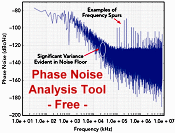 This "A
Phase Noise Analysis Tool for Sparse Numerical Phase Noise Data," article by
Shawn Logan, appears in the July 2024 issue of Microwave Journal magazine.
He offers the free software tool described therein. He begins: "This article describes
a phase noise analysis tool that creates a numerical model from discrete phase noise
data. The tool includes an adaptive algorithm to identify spurious deterministic
components in the data. It also creates a physics-based numerical model for the
random noise component. Despite its apparent simplicity, analyzing the temporal
and Fourier characteristics of an oscillator from its phase noise characteristic
presents challenges to designers and those wishing to specify an oscillator for
an application..." This "A
Phase Noise Analysis Tool for Sparse Numerical Phase Noise Data," article by
Shawn Logan, appears in the July 2024 issue of Microwave Journal magazine.
He offers the free software tool described therein. He begins: "This article describes
a phase noise analysis tool that creates a numerical model from discrete phase noise
data. The tool includes an adaptive algorithm to identify spurious deterministic
components in the data. It also creates a physics-based numerical model for the
random noise component. Despite its apparent simplicity, analyzing the temporal
and Fourier characteristics of an oscillator from its phase noise characteristic
presents challenges to designers and those wishing to specify an oscillator for
an application..."
 With more than 1000
custom-built symbols, this has got to be the most comprehensive set of
Visio Symbols available
for RF, analog, and digital system and schematic drawings! Every object has
been built to fit proportionally on the provided A-, B- and C-size drawing page
templates (or can use your own). Symbols are provided for equipment racks and test
equipment, system block diagrams, conceptual drawings, and schematics. Unlike previous
versions, these are NOT Stencils, but instead are all contained on tabbed pages
within a single Visio document. That puts everything in front of you in its full
glory. Just copy and paste what you need on your drawing... With more than 1000
custom-built symbols, this has got to be the most comprehensive set of
Visio Symbols available
for RF, analog, and digital system and schematic drawings! Every object has
been built to fit proportionally on the provided A-, B- and C-size drawing page
templates (or can use your own). Symbols are provided for equipment racks and test
equipment, system block diagrams, conceptual drawings, and schematics. Unlike previous
versions, these are NOT Stencils, but instead are all contained on tabbed pages
within a single Visio document. That puts everything in front of you in its full
glory. Just copy and paste what you need on your drawing...
Anatech Intros
3 New Ceramic Bandpass Models
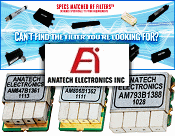 Anatech Electronics offers the industry's
largest portfolio of high-performance standard and customized RF and microwave filters
and filter-related products for military, commercial, aerospace and defense, and
industrial applications up to 40 GHz. Three new
ceramic bandpass filters have been announced for July 2024 - a 793 MHz bandpass
with a 5 MHz bandwidth, an 806 MHz bandpass with a bandwidth of 30 MHz,
and an 847 MHz bandpass with a bandwidth of 30 MHz. All have an insertion
loss of no more than 4 dB. Custom RF power filter and directional couplers
designs can be designed and produced with required connector types when a standard
cannot be found... Anatech Electronics offers the industry's
largest portfolio of high-performance standard and customized RF and microwave filters
and filter-related products for military, commercial, aerospace and defense, and
industrial applications up to 40 GHz. Three new
ceramic bandpass filters have been announced for July 2024 - a 793 MHz bandpass
with a 5 MHz bandwidth, an 806 MHz bandpass with a bandwidth of 30 MHz,
and an 847 MHz bandpass with a bandwidth of 30 MHz. All have an insertion
loss of no more than 4 dB. Custom RF power filter and directional couplers
designs can be designed and produced with required connector types when a standard
cannot be found...
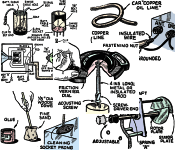 It is hard to believe in 1936, a time when
cars were huge and dashboards had almost nothing behind them except some heater
ducts, that access to something as simple as a radio speaker would be difficult.
Evidently it could be, according to the first-place winner of "Short-Cut"
in Radio-Craft magazine. There was not then the rat's nest of wires, air
bags, and control cables found in modern autos. Voluminous trunks back in the day,
and engine compartments that you could almost stand in while changing spark plugs
(I once had a 6-cylinder, 1970 Chevy truck that I could do that with) were typical.
Compare that to modern weenie trunks barely large enough to hold groceries and engine
compartments accommodating front-wheel-drive transmissions and dozens of emission-reduction... It is hard to believe in 1936, a time when
cars were huge and dashboards had almost nothing behind them except some heater
ducts, that access to something as simple as a radio speaker would be difficult.
Evidently it could be, according to the first-place winner of "Short-Cut"
in Radio-Craft magazine. There was not then the rat's nest of wires, air
bags, and control cables found in modern autos. Voluminous trunks back in the day,
and engine compartments that you could almost stand in while changing spark plugs
(I once had a 6-cylinder, 1970 Chevy truck that I could do that with) were typical.
Compare that to modern weenie trunks barely large enough to hold groceries and engine
compartments accommodating front-wheel-drive transmissions and dozens of emission-reduction...
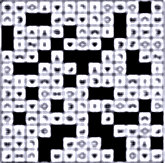 Fellow cruciverbalists, here from a 1963
edition of Electronics World magazine is an
electronics-themed crossword puzzle for your mid-week enjoyment. You can click
on the grid for a larger, printable, write-on-able paper version. If you are an
avid worker of crosswords and don't already know it, I have created hundreds over
the last two decades. Unlike this crossword from Electronics World (and
most others for that matter), RF Cafe's technology-themed crossword puzzles
have only hand-picked words related to engineering and science... Fellow cruciverbalists, here from a 1963
edition of Electronics World magazine is an
electronics-themed crossword puzzle for your mid-week enjoyment. You can click
on the grid for a larger, printable, write-on-able paper version. If you are an
avid worker of crosswords and don't already know it, I have created hundreds over
the last two decades. Unlike this crossword from Electronics World (and
most others for that matter), RF Cafe's technology-themed crossword puzzles
have only hand-picked words related to engineering and science...
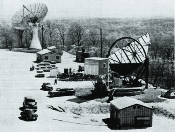 The
Echo 1 communications satellite was launched in August of 1960, shortly
before this October 1960 Radio-Electronics magazine "News Briefs" item
reported on the preparations made for the first message to be bounded off the metallic
film covering its spherical shape. The November 1960 issue of Electronics World
magazine included an infomercial from Bell Telephone Laboratories claiming success.
While waiting for Echo 1 to be placed into orbit, tests were made of the round-trip
signaling system by bouncing signals off the moon. The moon, being about a quarter
million miles farther away from Echo's orbit and having a much less radio-reflective
surface than Echo, resulted in a significantly weaker received signal. That confirmed
the system would perform well with the Echo 1 signal. In fact, as mentioned
above... The
Echo 1 communications satellite was launched in August of 1960, shortly
before this October 1960 Radio-Electronics magazine "News Briefs" item
reported on the preparations made for the first message to be bounded off the metallic
film covering its spherical shape. The November 1960 issue of Electronics World
magazine included an infomercial from Bell Telephone Laboratories claiming success.
While waiting for Echo 1 to be placed into orbit, tests were made of the round-trip
signaling system by bouncing signals off the moon. The moon, being about a quarter
million miles farther away from Echo's orbit and having a much less radio-reflective
surface than Echo, resulted in a significantly weaker received signal. That confirmed
the system would perform well with the Echo 1 signal. In fact, as mentioned
above...
Exodus AMP4022DBP-4KW X-Band
Pulse SSPA
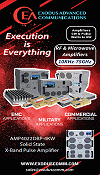 Exodus Advanced Communications, is a multinational
RF communication equipment and engineering service company serving both commercial
and government entities and their affiliates worldwide. We are pleased to announce
the Exodus Advanced Communications'
AMP4022DBP-4KW X-Band, 8-12 GHz Pulse Amplifier, which is designed for
Pulse/HIRF, EMC/EMI Mil-Std 461/464 and Radar applications. Providing Superb Pulse
Fidelity and up to 100 μsec pulse widths. Duty cycles to 6% with a minimum
66 dB gain. Available monitoring parameters for Forward/Reflected power in
Watts & dBm, VSWR, voltage, current, temperature sensing for outstanding reliability
and ruggedness for compact integrations... Exodus Advanced Communications, is a multinational
RF communication equipment and engineering service company serving both commercial
and government entities and their affiliates worldwide. We are pleased to announce
the Exodus Advanced Communications'
AMP4022DBP-4KW X-Band, 8-12 GHz Pulse Amplifier, which is designed for
Pulse/HIRF, EMC/EMI Mil-Std 461/464 and Radar applications. Providing Superb Pulse
Fidelity and up to 100 μsec pulse widths. Duty cycles to 6% with a minimum
66 dB gain. Available monitoring parameters for Forward/Reflected power in
Watts & dBm, VSWR, voltage, current, temperature sensing for outstanding reliability
and ruggedness for compact integrations...
|
 It has been a while since I posted a
Carl and Jerry high-tech saga. John T. Frye created the duo of teenage
sleuths in 1954 for the very first issue of Popular Electronics magazine.
More than 100 adventures carried Carl and Jerry from high school through college.
Their practical jokes, crime solving, and mystery investigations incorporated microphones,
timers, cameras, Ham radio, transformers, metal detectors, remote controllers, home
brew circuits, photodetectors, and a host of other gadgets that could be pulled
from a stash of parts in Carl's or Jerry's basement workshop, or borrowed from a
friend. In this story, Carl and Jerry, now students at Parvoo University in Indiana,
have an unexpected confrontation with a radio operator while... It has been a while since I posted a
Carl and Jerry high-tech saga. John T. Frye created the duo of teenage
sleuths in 1954 for the very first issue of Popular Electronics magazine.
More than 100 adventures carried Carl and Jerry from high school through college.
Their practical jokes, crime solving, and mystery investigations incorporated microphones,
timers, cameras, Ham radio, transformers, metal detectors, remote controllers, home
brew circuits, photodetectors, and a host of other gadgets that could be pulled
from a stash of parts in Carl's or Jerry's basement workshop, or borrowed from a
friend. In this story, Carl and Jerry, now students at Parvoo University in Indiana,
have an unexpected confrontation with a radio operator while...
• FCC Lowering
Cellphone Call/Video Rates for Prisoners
•
CrowdStrike Glitch Largely Spares Radio
•
Radio's Digital Wake-up Call
• Romania
Beats Germany and Austria in Fiber Penetration
• 5G
Improving Due to Midband Deployments
 Innovative Power Products has been designing
and manufacturing RF and Microwave passive components since 2005. We use the latest
design tools available to build our baluns, 90-degree couplers, directional couplers,
combiners/dividers, single-ended transformers, resistors, terminations, and custom
products. Applications in military, medical, industrial, and commercial markets
are serviced around the world. Products listed on the website link to detailed mechanical
drawings, electrical specifications, and performance data. If you cannot find a
product that meets your requirements on our website, contact us to speak with one
of our experienced design engineers about your project. Innovative Power Products has been designing
and manufacturing RF and Microwave passive components since 2005. We use the latest
design tools available to build our baluns, 90-degree couplers, directional couplers,
combiners/dividers, single-ended transformers, resistors, terminations, and custom
products. Applications in military, medical, industrial, and commercial markets
are serviced around the world. Products listed on the website link to detailed mechanical
drawings, electrical specifications, and performance data. If you cannot find a
product that meets your requirements on our website, contact us to speak with one
of our experienced design engineers about your project.
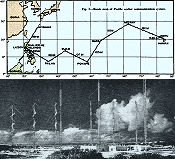 The November 1961 issue of Radio-Electronics
magazine contained a couple articles on long-distance wireless communications by
exploiting the reflective properties of the Earth's upper atmosphere. "Nature's
Invisible Radio Mirror" is one of the others. This "Pacific
Scatter Communications System" (PSCS) article describes a series of transmit
/ receive stations located on eight Pacific islands used to pass voice and teleprinter
messages from areas around the Philippines and Okinawa to Hawaii. At the time, it
was the longest of such systems, with expansion sites being constructed to Taiwan
and beyond. Both ionospheric (34-55 MHz, 40-60 kW) and tropospheric (800 MHz,
1 kW) scatter / reflection were exploited. Prior to the PSCS, communications
were often broken and/or filled with heavy interference... The November 1961 issue of Radio-Electronics
magazine contained a couple articles on long-distance wireless communications by
exploiting the reflective properties of the Earth's upper atmosphere. "Nature's
Invisible Radio Mirror" is one of the others. This "Pacific
Scatter Communications System" (PSCS) article describes a series of transmit
/ receive stations located on eight Pacific islands used to pass voice and teleprinter
messages from areas around the Philippines and Okinawa to Hawaii. At the time, it
was the longest of such systems, with expansion sites being constructed to Taiwan
and beyond. Both ionospheric (34-55 MHz, 40-60 kW) and tropospheric (800 MHz,
1 kW) scatter / reflection were exploited. Prior to the PSCS, communications
were often broken and/or filled with heavy interference...
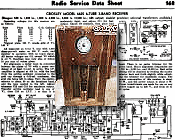 I originally stated that I could not find
a single photograph of a
Crosley
6625, 3-band radio. However, RF Cafe visitor Bruce C. read that and sent
me a link to his Crosley Model 6625 being advertised for sale in the Boston area
on Craigslist (for $350 - click here to view it). A couple images of it can be seen
by clicking on the thumbnail. The Radio Service Data Sheet was part of a group of
six such instances that appeared in the June 1936 issue of Radio-Craft
magazine... I originally stated that I could not find
a single photograph of a
Crosley
6625, 3-band radio. However, RF Cafe visitor Bruce C. read that and sent
me a link to his Crosley Model 6625 being advertised for sale in the Boston area
on Craigslist (for $350 - click here to view it). A couple images of it can be seen
by clicking on the thumbnail. The Radio Service Data Sheet was part of a group of
six such instances that appeared in the June 1936 issue of Radio-Craft
magazine...
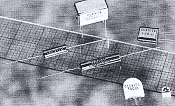 The introduction of low cost, small-footprint
ceramic filters were unquestionably a boon to efforts at reduction in end-product
package size and manufacturing cost. Very good Q and selectivity, no tuning required,
and good temperature stability made them perfect for use as IF filters in broadcast
radio receivers, at 10.7 MHz (FM) and 455 kHz (AM). They became available
for commercial use around 1960 about a decade before this Electronics World
magazine article hit the news stand. This publically available paper published in
2000 from the IEEE provides some historical perspective to ceramic filters: The
History of Ceramic Filters, by Satoru Fujishima. The Clevite Corporation, for which
author Reg Zimmerman worked, is mentioned in the IEEE... The introduction of low cost, small-footprint
ceramic filters were unquestionably a boon to efforts at reduction in end-product
package size and manufacturing cost. Very good Q and selectivity, no tuning required,
and good temperature stability made them perfect for use as IF filters in broadcast
radio receivers, at 10.7 MHz (FM) and 455 kHz (AM). They became available
for commercial use around 1960 about a decade before this Electronics World
magazine article hit the news stand. This publically available paper published in
2000 from the IEEE provides some historical perspective to ceramic filters: The
History of Ceramic Filters, by Satoru Fujishima. The Clevite Corporation, for which
author Reg Zimmerman worked, is mentioned in the IEEE...
 I hadn't thought of this angle on the announced
Windows 10 end-of-life plans for July 2025. I own four computers running
Win10, that are not qualified for Win11. "Microsoft aims to boost the PC market
with artificial intelligence and Windows 11, but a collateral consequence of those
moves could be an early trip to a landfill for many computers. 'Windows 11 itself
does not directly contribute to e-waste,' said Kieren Jessop, an analyst with Canalys,
a global market research company. 'However, due to its hardware requirements, it
can indirectly increase e-waste,' he told TechNewsWorld. 'A significant share of
the global installed base is unable to upgrade to Win11 because of the TPM 2.0 chip,
which contributes to Win11's security.' He noted that Canalys estimates approximately
20% of the global Windows installed base can't upgrade its over 200 million devices..." I hadn't thought of this angle on the announced
Windows 10 end-of-life plans for July 2025. I own four computers running
Win10, that are not qualified for Win11. "Microsoft aims to boost the PC market
with artificial intelligence and Windows 11, but a collateral consequence of those
moves could be an early trip to a landfill for many computers. 'Windows 11 itself
does not directly contribute to e-waste,' said Kieren Jessop, an analyst with Canalys,
a global market research company. 'However, due to its hardware requirements, it
can indirectly increase e-waste,' he told TechNewsWorld. 'A significant share of
the global installed base is unable to upgrade to Win11 because of the TPM 2.0 chip,
which contributes to Win11's security.' He noted that Canalys estimates approximately
20% of the global Windows installed base can't upgrade its over 200 million devices..."
 "Parasitics
refers to undesirable characteristics and unwanted effects that deviate from ideal
behavior in electronic components and circuits. These characteristics are often
modeled using equivalent lumped elements, which include resistance, capacitance,
and inductance. It is crucial to account for their non-ideal, parasitic characteristics
when using passive components to mitigate electromagnetic interference (EMI). You
might encounter situations where you initially attempt to employ a component to
suppress an unwanted signal, only to discover that it does not yield the expected..." "Parasitics
refers to undesirable characteristics and unwanted effects that deviate from ideal
behavior in electronic components and circuits. These characteristics are often
modeled using equivalent lumped elements, which include resistance, capacitance,
and inductance. It is crucial to account for their non-ideal, parasitic characteristics
when using passive components to mitigate electromagnetic interference (EMI). You
might encounter situations where you initially attempt to employ a component to
suppress an unwanted signal, only to discover that it does not yield the expected..."
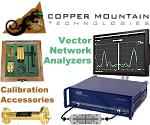 Copper Mountain Technologies develops innovative
and robust RF test and measurement solutions for engineers all over the world. Copper
Mountain's extensive line of unique form factor
Vector Network Analyzers
include an RF measurement module and a software application which runs on any Windows
PC, laptop or tablet, connecting to the measurement hardware via USB interface.
The result is a lower cost, faster, more effective test process that fits into the
modern workspace in lab, production, field and secure testing environments. 50 Ω
and 75 Ω models are available, along with a full line of precision calibration
and connector adaptors. Copper Mountain Technologies develops innovative
and robust RF test and measurement solutions for engineers all over the world. Copper
Mountain's extensive line of unique form factor
Vector Network Analyzers
include an RF measurement module and a software application which runs on any Windows
PC, laptop or tablet, connecting to the measurement hardware via USB interface.
The result is a lower cost, faster, more effective test process that fits into the
modern workspace in lab, production, field and secure testing environments. 50 Ω
and 75 Ω models are available, along with a full line of precision calibration
and connector adaptors.
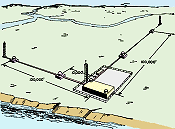 The advent of missiles and nuclear warheads
which can fly long distances and be virtually unstoppable once launched ICBMs came
online shortly before this "Accurate
Missile Tracking" item appeared in a 1960 issue of Radio-Electronics
magazine. NATO and Warsaw Pact nations raced to develop both offensive and defensive
systems to help be able to defend itself against aggressors. The Cold War was on.
Eventually, all sides either unilaterally or multilaterally possessed enough nuclear
warheads - and the ability to deliver them - to cause everyone to fear what would
happen in the aftermath of a global nuclear war, with radioactive fallout settling
all over the globe. While that scenario is undesirable, an unexpected outcome... The advent of missiles and nuclear warheads
which can fly long distances and be virtually unstoppable once launched ICBMs came
online shortly before this "Accurate
Missile Tracking" item appeared in a 1960 issue of Radio-Electronics
magazine. NATO and Warsaw Pact nations raced to develop both offensive and defensive
systems to help be able to defend itself against aggressors. The Cold War was on.
Eventually, all sides either unilaterally or multilaterally possessed enough nuclear
warheads - and the ability to deliver them - to cause everyone to fear what would
happen in the aftermath of a global nuclear war, with radioactive fallout settling
all over the globe. While that scenario is undesirable, an unexpected outcome...
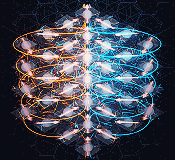 Researchers discovered that nickel iodide
exhibits exceptional
magnetoelectric coupling, making it highly suitable for use in high-speed and
energy-efficient technologies such as magnetic memories and quantum computing. The
layered multiferroic material nickel iodide may be the best candidate yet for devices
such as magnetic computer memory that are extremely fast and compact. Multiferroics
and Nickel Iodide For decades, scientists have been studying a group of unusual
materials called multiferroics that could be useful for a range of applications
including computer memory, chemical sensors and quantum computers. In a study published
in Nature, researchers from The University of Texas at Austin and the Max... Researchers discovered that nickel iodide
exhibits exceptional
magnetoelectric coupling, making it highly suitable for use in high-speed and
energy-efficient technologies such as magnetic memories and quantum computing. The
layered multiferroic material nickel iodide may be the best candidate yet for devices
such as magnetic computer memory that are extremely fast and compact. Multiferroics
and Nickel Iodide For decades, scientists have been studying a group of unusual
materials called multiferroics that could be useful for a range of applications
including computer memory, chemical sensors and quantum computers. In a study published
in Nature, researchers from The University of Texas at Austin and the Max...
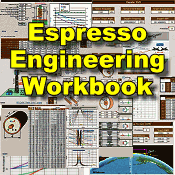 The newest release of RF Cafe's spreadsheet
(Excel) based engineering and science calculator is now available -
Espresso
Engineering Workbook™. Among other additions, it now has a Butterworth Bandpass
Calculator, and a Highpass Filter Calculator that does not just gain, but also
phase and group delay! Since 2002, the
original Calculator Workbook has been available as a free download. Continuing
the tradition, RF Cafe Espresso Engineering Workbook™ is also
provided at no cost,
compliments of my generous sponsors. The original calculators are included, but
with a vastly expanded and improved user interface. Error-trapped user input cells
help prevent entry of invalid values. An extensive use of Visual Basic for Applications
(VBA) functions now do most of the heavy lifting with calculations, and facilitates
a wide user-selectable choice of units for voltage, frequency, speed, temperature,
power, wavelength, weight, etc. In fact, a full page of units conversion calculators
is included. A particularly handy feature is the ability to specify the the number
of significant digits to display. Drop-down menus are provided for convenience... The newest release of RF Cafe's spreadsheet
(Excel) based engineering and science calculator is now available -
Espresso
Engineering Workbook™. Among other additions, it now has a Butterworth Bandpass
Calculator, and a Highpass Filter Calculator that does not just gain, but also
phase and group delay! Since 2002, the
original Calculator Workbook has been available as a free download. Continuing
the tradition, RF Cafe Espresso Engineering Workbook™ is also
provided at no cost,
compliments of my generous sponsors. The original calculators are included, but
with a vastly expanded and improved user interface. Error-trapped user input cells
help prevent entry of invalid values. An extensive use of Visual Basic for Applications
(VBA) functions now do most of the heavy lifting with calculations, and facilitates
a wide user-selectable choice of units for voltage, frequency, speed, temperature,
power, wavelength, weight, etc. In fact, a full page of units conversion calculators
is included. A particularly handy feature is the ability to specify the the number
of significant digits to display. Drop-down menus are provided for convenience...
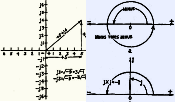 As with many ancient mathematical and scientific
concepts the provenance of
imaginary numbers is open to opinions. The term "imaginary" seems to discredit
the veracity of the concept, since after all, what good is an imaginary entity?
The Wikipedia account of imaginary numbers cite the works of Heron of Alexandria,
Bombelli, Cardano, Descartes, Euler, and Gauss, among others. In fact, the raison
d'être for imaginary numbers was to facilitate the solving of equations involving
even roots of negative numbers. If you are not familiar with such things, a valid
root of a number (radicand) must be able to regenerate itself by raising itself
to the same power (exponent) as the index number of the root. For example, the second... As with many ancient mathematical and scientific
concepts the provenance of
imaginary numbers is open to opinions. The term "imaginary" seems to discredit
the veracity of the concept, since after all, what good is an imaginary entity?
The Wikipedia account of imaginary numbers cite the works of Heron of Alexandria,
Bombelli, Cardano, Descartes, Euler, and Gauss, among others. In fact, the raison
d'être for imaginary numbers was to facilitate the solving of equations involving
even roots of negative numbers. If you are not familiar with such things, a valid
root of a number (radicand) must be able to regenerate itself by raising itself
to the same power (exponent) as the index number of the root. For example, the second...
 These three
electronics-themed comics appeared in the February 1953 issue of Radio-Electronics
magazine. The first one showing the television repairman employing a contortionist
technique in order to tweak the picture is pretty good. I have seen an advertisement
in one of these magazines offering a deflection coil alignment signal generator
box that had a mirror mounted inside the cover specifically for doing the job that
tech is doing in the comic. Another comic no doubt hit home with in-home servicemen
of the day; at least the owner was honest. The other plays off a brand of humor
common in the day that demonstrated the public's fascination with all the newfangled
technology showing up every day... These three
electronics-themed comics appeared in the February 1953 issue of Radio-Electronics
magazine. The first one showing the television repairman employing a contortionist
technique in order to tweak the picture is pretty good. I have seen an advertisement
in one of these magazines offering a deflection coil alignment signal generator
box that had a mirror mounted inside the cover specifically for doing the job that
tech is doing in the comic. Another comic no doubt hit home with in-home servicemen
of the day; at least the owner was honest. The other plays off a brand of humor
common in the day that demonstrated the public's fascination with all the newfangled
technology showing up every day...
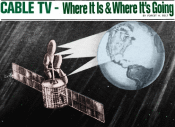 According to this 1972 article in Popular
Electronics magazine, cable television began around 1950. The system was very
different that what we have nearly 70 years later. The familiar acronym CATV does
not stand for CAble TeleVision, but rather
Community Access TeleVision. CATV, as originally implemented, was a means of
bringing broadcast TV to areas either too remote or too shielded from over-the-air
(OTA) RF signals to provide good signal reception. Depending on the need, CATV could
range from re-broadcasting of signals into targeted areas or sending signals through
cable (originally unshielded) to individual homes... According to this 1972 article in Popular
Electronics magazine, cable television began around 1950. The system was very
different that what we have nearly 70 years later. The familiar acronym CATV does
not stand for CAble TeleVision, but rather
Community Access TeleVision. CATV, as originally implemented, was a means of
bringing broadcast TV to areas either too remote or too shielded from over-the-air
(OTA) RF signals to provide good signal reception. Depending on the need, CATV could
range from re-broadcasting of signals into targeted areas or sending signals through
cable (originally unshielded) to individual homes...
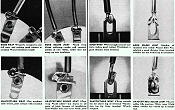 As mentioned previously, my professional
electronics career began with the U.S. Air Force in late 1978. As an Air Traffic
Control Radar Repairman (AFSC 303x1), the first phase of training was basic electronics,
and a short course on proper soldering techniques. A lot of emphasis was placed
on removal of the faulty component without damaging its environment (circuit board,
point-to-point chassis connections, etc.), and then to properly install the new
component, also without damaging the environment. We learned about forming component
leads so as not to stress them mechanically, orientation and placement, cleaning
the connections both before and after soldering, and then soldering technique. We
also learned how to repair circuit boards (only singe and double sided). As shown
in this 1961 Radio-Electronics magazine article entitled "Technician's
Guide to Good Soldering," there is a preferred way to tin component... As mentioned previously, my professional
electronics career began with the U.S. Air Force in late 1978. As an Air Traffic
Control Radar Repairman (AFSC 303x1), the first phase of training was basic electronics,
and a short course on proper soldering techniques. A lot of emphasis was placed
on removal of the faulty component without damaging its environment (circuit board,
point-to-point chassis connections, etc.), and then to properly install the new
component, also without damaging the environment. We learned about forming component
leads so as not to stress them mechanically, orientation and placement, cleaning
the connections both before and after soldering, and then soldering technique. We
also learned how to repair circuit boards (only singe and double sided). As shown
in this 1961 Radio-Electronics magazine article entitled "Technician's
Guide to Good Soldering," there is a preferred way to tin component...
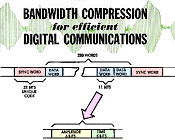 Bandwidth compression is a major strategy
in today's seriously overcrowded communications spectrum. Compression has occurred
both through m-ary digital modulation and through downsampling of voice - the latter
of which is partially responsible for the crappy quality of cellphones versus old
fashioned copper landline telephones. The mathematics of sampling theory are complex
to say the least, and its ability to accommodate reliable communications in the
midst of incredibly dense interference is amazing. This article appeared in a 1969
issue of Electronics World magazine, near the beginning of digital communications.
Probably the earliest form... Bandwidth compression is a major strategy
in today's seriously overcrowded communications spectrum. Compression has occurred
both through m-ary digital modulation and through downsampling of voice - the latter
of which is partially responsible for the crappy quality of cellphones versus old
fashioned copper landline telephones. The mathematics of sampling theory are complex
to say the least, and its ability to accommodate reliable communications in the
midst of incredibly dense interference is amazing. This article appeared in a 1969
issue of Electronics World magazine, near the beginning of digital communications.
Probably the earliest form...
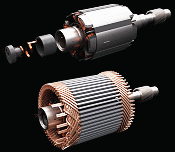 "Global efforts to combat climate change
hinge on pivoting sharply away from fossil fuels. To do that will require electrifying
transportation, primarily by shifting from vehicles with combustion engines to ones
with electric drive trains. Such a massive shift will inevitably mean far greater
use of electric traction motors, nearly all of which rely on magnets that contain
rare earth elements, which cause
substantial environmental degradation when their ores are extracted and then processed
into industrially useful forms. And for automakers outside of China, there is an
additional deterrent: Roughly 90% of processed rare earth elements now come from
China, so for these companies, increasing dependence on rare earths means growing
vulnerability in critical supply chains. Against this backdrop, massive efforts
are underway to design and test advanced electric-vehicle (EV) motors that do not
use rare earth elements..." "Global efforts to combat climate change
hinge on pivoting sharply away from fossil fuels. To do that will require electrifying
transportation, primarily by shifting from vehicles with combustion engines to ones
with electric drive trains. Such a massive shift will inevitably mean far greater
use of electric traction motors, nearly all of which rely on magnets that contain
rare earth elements, which cause
substantial environmental degradation when their ores are extracted and then processed
into industrially useful forms. And for automakers outside of China, there is an
additional deterrent: Roughly 90% of processed rare earth elements now come from
China, so for these companies, increasing dependence on rare earths means growing
vulnerability in critical supply chains. Against this backdrop, massive efforts
are underway to design and test advanced electric-vehicle (EV) motors that do not
use rare earth elements..."
 TotalTemp Technologies has more than 40
years of combined experience providing thermal platforms.
Thermal Platforms are
available to provide temperatures between -100°C and +200°C for cryogenic cooling,
recirculating & circulating coolers, temperature chambers and temperature controllers,
thermal range safety controllers, space simulation chambers, hybrid benchtop chambers,
custom systems and platforms. Manual and automated configurations for laboratory
and production environments. Please contact TotalTemp Technologies today to learn
how they can help your project. TotalTemp Technologies has more than 40
years of combined experience providing thermal platforms.
Thermal Platforms are
available to provide temperatures between -100°C and +200°C for cryogenic cooling,
recirculating & circulating coolers, temperature chambers and temperature controllers,
thermal range safety controllers, space simulation chambers, hybrid benchtop chambers,
custom systems and platforms. Manual and automated configurations for laboratory
and production environments. Please contact TotalTemp Technologies today to learn
how they can help your project.
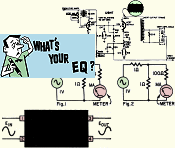 Here we go with three more circuit puzzlers
from the November 1961 issue of Radio-Electronics magazine. The feature
title, "What's
Your EQ?," is a play on "IQ," but instead of Intelligence Quotient it means
Electronics Quotient. The first challenge is a simple application of series and
parallel resistance combinations and Ohm's Law. With the Black Box problem, don't
hurt your brain too much. The author's solution is unarguably the simplest. The
last, "Impossible Voltages," was devised by TV troubleshooting master Jack Darr,
who publishes regular columns on the art/science, so few will probably get it right
- unless you have experience with circuit containing complex mixes of resistors,
capacitors, inductors, and transformers. It evidently stems from an actual case
he worked on. Then again... Here we go with three more circuit puzzlers
from the November 1961 issue of Radio-Electronics magazine. The feature
title, "What's
Your EQ?," is a play on "IQ," but instead of Intelligence Quotient it means
Electronics Quotient. The first challenge is a simple application of series and
parallel resistance combinations and Ohm's Law. With the Black Box problem, don't
hurt your brain too much. The author's solution is unarguably the simplest. The
last, "Impossible Voltages," was devised by TV troubleshooting master Jack Darr,
who publishes regular columns on the art/science, so few will probably get it right
- unless you have experience with circuit containing complex mixes of resistors,
capacitors, inductors, and transformers. It evidently stems from an actual case
he worked on. Then again...
 This meme appeared online, in response to
Secret Service Director Kimberly Cheatle claiming there were no counter-sniper
agents on the roof of the building where the 20-year-old would-be assassin managed
to navigate because the slope would pose an unacceptable danger to expertly trained
federales. I'm guessing she has never been on top of any roof in her entire life
- not even at PepsiCo where she previously earned her security credentials. Now,
having this inside information about what an effective barrier to armed federal
agents looks like, you can easily defend your home against an uninvited visit. This meme appeared online, in response to
Secret Service Director Kimberly Cheatle claiming there were no counter-sniper
agents on the roof of the building where the 20-year-old would-be assassin managed
to navigate because the slope would pose an unacceptable danger to expertly trained
federales. I'm guessing she has never been on top of any roof in her entire life
- not even at PepsiCo where she previously earned her security credentials. Now,
having this inside information about what an effective barrier to armed federal
agents looks like, you can easily defend your home against an uninvited visit.
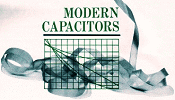 Capacitor science has evolved at a very
rapid rate since the beginning of electronics and electrical circuitry. Since the
early Leyden jar (named after the city where it was invented by Ewald Georg von
Kleist) type capacitor, continual advancements in materials for electrolytes and
metal plates, as well as in packaging, have led to incredibly high storage density,
miniature size, high voltage and current, mounting configuration, low ESR, high
frequency operation, price, stability, temperature extreme tolerance, and other
parameters. It is always instructive and interesting to read the history that has
led to the
current state of capacitor art. This 1963 Electronics World magazine
article does just that... Capacitor science has evolved at a very
rapid rate since the beginning of electronics and electrical circuitry. Since the
early Leyden jar (named after the city where it was invented by Ewald Georg von
Kleist) type capacitor, continual advancements in materials for electrolytes and
metal plates, as well as in packaging, have led to incredibly high storage density,
miniature size, high voltage and current, mounting configuration, low ESR, high
frequency operation, price, stability, temperature extreme tolerance, and other
parameters. It is always instructive and interesting to read the history that has
led to the
current state of capacitor art. This 1963 Electronics World magazine
article does just that...
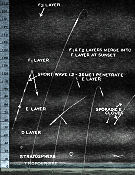 The International Geographic Year (IGY),
which ended up lasting about 18 months, ran from July 1957 through December 1958.
One of its main purposes was to explore and quantify the nature of the
electrically conductive region of the Earth's atmosphere, within which and through
which future sounding rockets, orbiting satellites, and deep space probes would
operate. Sputnik launched at the end of 1957, and Echo launched in mid-1960. Both
professional and amateur radio operators had already ascertained significant clues
about the ionosphere's characteristics by observing its affects on electromagnetic
signals. Direct, in-situ measurements confirmed some beliefs while disproving others.
More than 65 years later, we know much significantly more about the ionosphere,
having sent thousands of craft - including many manned - into and through it. When
this "Nature's Invisible Radio Mirror" article appeared... The International Geographic Year (IGY),
which ended up lasting about 18 months, ran from July 1957 through December 1958.
One of its main purposes was to explore and quantify the nature of the
electrically conductive region of the Earth's atmosphere, within which and through
which future sounding rockets, orbiting satellites, and deep space probes would
operate. Sputnik launched at the end of 1957, and Echo launched in mid-1960. Both
professional and amateur radio operators had already ascertained significant clues
about the ionosphere's characteristics by observing its affects on electromagnetic
signals. Direct, in-situ measurements confirmed some beliefs while disproving others.
More than 65 years later, we know much significantly more about the ionosphere,
having sent thousands of craft - including many manned - into and through it. When
this "Nature's Invisible Radio Mirror" article appeared...
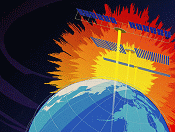 This whole concept seems so idiotic as to
be dismissible out-of-hand. Who legitimately thinks having
high power
energy beams raining down from space is a good idea? Evidently some people do.
Aside from the danger of coming into contact with a beam, surely there will be a
major increase in the ambient EM noise floor worldwide, and the massive orbiting
structures would further destroy the night sky. It seems anymore if I am watching
a particular area of the sky through my telescope, within a few minutes a satellite
will pass through the field of view. Per IEEE Spectrum magazine: "The accelerating
buildout of solar farms on Earth is already hitting speed bumps, including public
pushback against the large tracts of land required and a ballooning backlog of requests
for new transmission lines and grid connections. Energy experts have been warning
that electricity is likely to get more expensive and less reliable unless renewable
power that waxes and wanes under inconstant sunlight and wind..." This whole concept seems so idiotic as to
be dismissible out-of-hand. Who legitimately thinks having
high power
energy beams raining down from space is a good idea? Evidently some people do.
Aside from the danger of coming into contact with a beam, surely there will be a
major increase in the ambient EM noise floor worldwide, and the massive orbiting
structures would further destroy the night sky. It seems anymore if I am watching
a particular area of the sky through my telescope, within a few minutes a satellite
will pass through the field of view. Per IEEE Spectrum magazine: "The accelerating
buildout of solar farms on Earth is already hitting speed bumps, including public
pushback against the large tracts of land required and a ballooning backlog of requests
for new transmission lines and grid connections. Energy experts have been warning
that electricity is likely to get more expensive and less reliable unless renewable
power that waxes and wanes under inconstant sunlight and wind..."
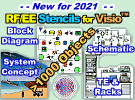 With more than 1000
custom-built stencils, this has got to be the most comprehensive set of
Visio Stencils available
for RF, analog, and digital system and schematic drawings! Every stencil symbol
has been built to fit proportionally on the included A-, B-, and C-size drawing
page templates (or use your own page if preferred). Components are provided for
system block diagrams, conceptual drawings, schematics, test equipment, racks, and
more. Page templates are provided with a preset scale (changeable) for a good presentation
that can incorporate all provided symbols... With more than 1000
custom-built stencils, this has got to be the most comprehensive set of
Visio Stencils available
for RF, analog, and digital system and schematic drawings! Every stencil symbol
has been built to fit proportionally on the included A-, B-, and C-size drawing
page templates (or use your own page if preferred). Components are provided for
system block diagrams, conceptual drawings, schematics, test equipment, racks, and
more. Page templates are provided with a preset scale (changeable) for a good presentation
that can incorporate all provided symbols...
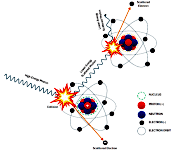 "Electronics are used to communicate with
loved ones, manage finances, fly aircraft, autonomously drive us to work, and even
save lives. As we achieve further advances in technology, electronics will continue
to lead the way in adapting these technologies into new critical systems and processes.
The benefits that electronics have provided us are undeniable. However, there is
a significant drawback as the implementation of sensitive electronic circuitry continues
to increase our vulnerability to the effects of electromagnetic threats such as
an EMP attack. An
electromagnetic
pulse (EMP) is defined as a high amplitude, short duration, broadband pulse
of electromagnetic energy that can have devastating effects on unprotected electronic
equipment and systems. EMPs are historically known..." "Electronics are used to communicate with
loved ones, manage finances, fly aircraft, autonomously drive us to work, and even
save lives. As we achieve further advances in technology, electronics will continue
to lead the way in adapting these technologies into new critical systems and processes.
The benefits that electronics have provided us are undeniable. However, there is
a significant drawback as the implementation of sensitive electronic circuitry continues
to increase our vulnerability to the effects of electromagnetic threats such as
an EMP attack. An
electromagnetic
pulse (EMP) is defined as a high amplitude, short duration, broadband pulse
of electromagnetic energy that can have devastating effects on unprotected electronic
equipment and systems. EMPs are historically known..."
|


































 Innovative Power Products
Innovative Power Products




 Copper Mountain Technologies
Copper Mountain Technologies






 Bandwidth compression
Bandwidth compression







